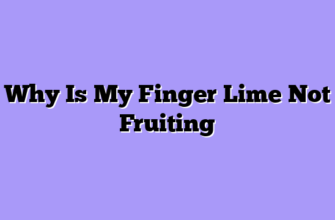Patience has never been my strong suit. Ask my wife – I’m the guy who checks the oven every five minutes when baking cookies. So when I first started growing finger limes eighteen years ago, the ripening timeline nearly drove me to madness. These little Australian gems operate on their own mysterious schedule, and learning to read their subtle signals became one of the most challenging yet rewarding aspects of my exotic fruit farming career.
I’ll never forget my first harvest attempt in 2007. I had thirty young finger lime trees that had finally started producing fruit after three agonizing years of growth. The small, elongated fruits hung like tiny green sausages from the branches, and I was convinced they were ready. After all, they looked mature, right? Wrong. Dead wrong. When I cut into those supposedly ripe fruits, I found disappointing, barely-formed vesicles that lacked the signature pop and burst of flavor that makes finger limes so special.
That frustrating experience taught me my first crucial lesson: finger limes don’t ripen like regular citrus. While oranges and lemons give you obvious color changes and soft-to-touch cues, finger limes are masters of deception. They’ll look ready weeks before they actually are, sitting there on the tree like little time bombs of potential, waiting for the perfect moment to reach their peak.
The standard answer you’ll hear is that finger limes take 4-6 months to ripen from flower to harvest. But here’s what eighteen years of growing these temperamental beauties has taught me – that timeline is about as reliable as a weather forecast. I’ve seen finger limes take anywhere from 12 weeks to 8 months to reach perfect ripeness, depending on factors that would make a meteorologist’s head spin.
Cracking the Code: Environmental Factors That Control Ripening
Temperature plays the starring role in this ripening drama. Think of finger limes as solar-powered flavor machines – they need consistent warmth to develop properly, but not too much heat or they’ll stress out and drop prematurely. I learned this the hard way during the scorching summer of 2012 when temperatures hit 105°F for two weeks straight. My trees responded by essentially hitting the pause button on ripening, extending what should have been a 5-month timeline into a 7-month marathon.

Rainfall patterns create another layer of complexity. Finger limes need consistent moisture during development, but too much rain during the final ripening stages can actually dilute the intense flavor concentration. I’ve noticed that fruits experiencing a dry period in their last month of ripening develop more concentrated vesicles with better texture and flavor intensity.
Here’s what I’ve observed affects finger lime ripening times:
- Temperature consistency – steady 70-85°F produces fastest, most reliable ripening
- Day length – longer days accelerate development significantly
- Tree age and health – mature, well-established trees ripen fruit faster
- Variety differences – some cultivars are naturally slower than others
- Fruit load – heavily loaded trees take longer per fruit to ripen
- Soil conditions – well-draining, nutrient-rich soil speeds development
The most fascinating discovery came when I started tracking individual fruits with tiny tags. I found that fruits on the same tree, even the same branch, could have ripening times that varied by 2-3 weeks. The ones getting optimal sun exposure and air circulation consistently ripened faster than those hidden in the canopy’s interior.
The Art of Perfect Timing: Reading the Subtle Signs
After years of observation, I’ve developed what I call my “finger lime ripening checklist.” It’s a systematic approach that’s saved me from countless premature harvests and helped me maximize the incredible flavor potential of these fruits.
My ripening assessment follows this precise sequence:
- Visual inspection – look for subtle color deepening and slight glossiness
- Gentle pressure test – ripe fruits yield slightly to gentle squeeze
- Stem attachment check – easily detached fruits are usually ready
- Sound test – gently shake near your ear; ripe fruits rattle slightly
- Vesicle sample – cut one open to check vesicle separation and pop
- Flavor confirmation – taste test for that signature intense burst
The color change is incredibly subtle – we’re talking about a shift that might not even register on a photograph. Green varieties develop a slightly deeper, richer green with a faint glossy sheen. Pink and red varieties show more obvious color development, but even then, you’re looking for saturation rather than dramatic change.
The pressure test requires a delicate touch – imagine testing the ripeness of a grape. Too firm, and the vesicles haven’t separated properly. Too soft, and you’ve missed the peak window. There’s a perfect middle ground where the fruit yields just slightly to gentle pressure while maintaining structural integrity.
But here’s my secret weapon: the rattle test. Ripe finger limes develop separated vesicles that actually move inside the fruit. When you gently shake a perfectly ripe finger lime near your ear, you can hear a faint rattling sound as those precious vesicles shift around. It sounds crazy, but this technique has never failed me.
| Ripening Stage | Timeline | Visual Cues | Texture | Vesicle Quality |
|---|---|---|---|---|
| Early (60%) | 3-4 months | Firm, matte finish | Hard, no yield | Poorly separated |
| Mid (80%) | 4-5 months | Slight sheen developing | Minimal give | Partial separation |
| Near-ripe (90%) | 5-6 months | Glossy, color deepening | Gentle yield | Good separation |
| Perfect (100%) | 6+ months | Rich color, full gloss | Optimal firmness | Complete separation |
| Over-ripe (declining) | 6.5+ months | Dull appearance | Too soft | Mushy vesicles |
Variety Variations and Seasonal Surprises
Different finger lime varieties march to their own drummers when it comes to ripening schedules. My red champagne finger limes are the speed demons of the bunch, often reaching perfect ripeness in 4-5 months under ideal conditions. They’re like the sports cars of the finger lime world – fast, flashy, and reliable.
Green varieties, particularly the traditional Australian green, are the tortoises in this race. They take their sweet time, often requiring 6-7 months to reach peak quality. But patience pays off – these slower-ripening varieties often develop the most complex flavor profiles and the firmest vesicle texture.

The seasonal variations continue to surprise me after all these years. Spring-set fruits generally ripen faster than those set in late summer or fall. I suspect it’s related to the increasing day length and warming temperatures that spring fruits experience during their development. Fall-set fruits face the challenge of ripening through winter months, which can extend their timeline significantly.
Weather patterns also create vintage years, just like wine grapes. The 2019 season produced finger limes with exceptional quality and relatively quick ripening times thanks to ideal temperature and rainfall patterns. Conversely, 2020’s erratic weather created one of my most challenging seasons, with ripening times all over the map.
One of my most valuable lessons came from tracking harvest data over multiple years. I discovered that finger limes follow roughly predictable patterns based on when they set fruit. Spring blooms (March-April) typically ripen in late summer to early fall. Summer blooms ripen in winter, while fall blooms might not reach peak ripeness until the following spring or early summer.
Today, when customers ask me how long finger limes take to ripen, I tell them it’s like asking how long it takes to write a symphony. The technical answer might be months, but the real answer is: as long as it takes to reach perfection. These little fruits have taught me that the best things in farming, like the best things in life, can’t be rushed. They ripen when they’re ready, not when we want them to.
The waiting game continues to test my patience, but the reward – that perfect burst of intense lime flavor from properly ripened vesicles – makes every day of waiting worthwhile. After eighteen years, I’ve finally learned to embrace the mystery and trust the process.








